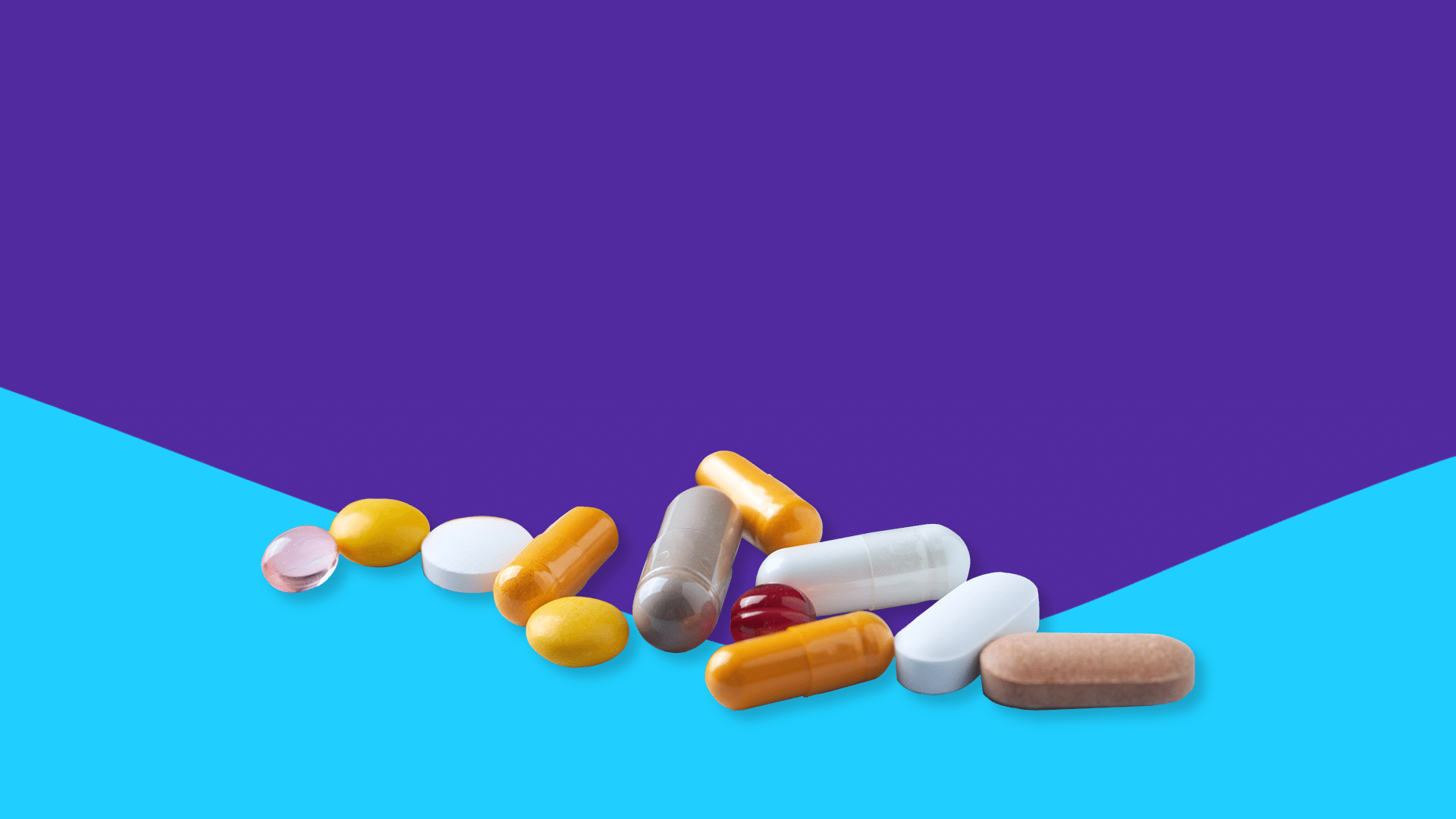Drug interactions | Vitamin and supplement interactions | Food interactions | Other contraindications | Signs of an interaction
Lipitor, the brand name for atorvastatin calcium, is a common medication used to help lower LDL (bad) cholesterol and triglycerides in the blood. Hypercholesterolemia is a type of hyperlipidemia that means there is too much non-HDL cholesterol and LDL cholesterol in the blood. This condition increases fatty deposits in arteries and the risk of blockages that can lead to cardiovascular disease. Available as an oral tablet, atorvastatin can reduce the risk of angina, stroke, heart attack, or certain heart and blood vessel problems. Like other statin medications, atorvastatin works to prevent cholesterol from being made in the liver. As a widely used medication, it’s important for people to be aware of the Lipitor (atorvastatin) interactions with other prescription drugs, food, and vitamins.
RELATED: Lipitor coupons | 13 things you might not know about Lipitor
Drug interactions
Along with other statin drugs, atorvastatin can interact with some prescription and over-the-counter medications. These atorvastatin interactions may cause increased levels of atorvastatin in the body contributing to a higher risk of side effects, or decreased levels of atorvastatin in the body contributing to possible ineffective doses. Increased levels of atorvastatin are associated with a higher chance of adverse effects, including myopathy, rhabdomyolysis, and liver enzyme abnormalities.
On the other hand, drug interactions with atorvastatin may lead to increased or decreased plasma concentrations of other drugs. These interactions may cause adverse effects as a result of too much of the interacting medication or cause ineffective dose as a result of not enough of the interacting medication.
Myopathy is a muscle disease that can be caused by statins. Symptoms of statin-induced myopathy include muscle weakness, fatigue, muscle pain, nocturnal cramping, muscle tenderness, and tendon pain. Rhabdomyolysis is a more serious condition that occurs when damaged muscle tissue releases its proteins and electrolytes into the blood. This process can result in permanent disability or fatality.
Liver enzyme abnormalities may indicate inflammation or damage to cells in the liver. A blood test can show elevated liver enzymes (most commonly ALT or AST) as the inflammation or damage can cause these enzymes to leak into the bloodstream. Before starting therapy with atorvastatin or another statin medication, the prescribing doctor may check liver enzymes with a blood test to ensure statin therapy is appropriate.
RELATED: Lipitor side effects and how to avoid them
A few medications are contraindicated with atorvastatin, which means that the combination is known to be harmful. These medications include cisapride, lonafarnib, posaconazole, and ritonavir.
There are other medications that should be avoided or used with caution and monitored. It’s always important to review all new medications with a healthcare provider to prevent dangerous drug interactions.
When it comes to atorvastatin, it’s important to be aware of using it along with medications used for the immune system, cholesterol, infections, birth control, heart failure, HIV or AIDS, and hepatitis C virus.
Lipitor (atorvastatin), Mevacor (lovastatin), and Zocor (simvastatin) are three statin medications referred to as statin 3A4 substrates. Statins that do not use the CYP3A4 isoenzyme metabolic pathway are referred to as statin non-3A4 substrates (pravastatin, fluvastatin, pitavastatin, and rosuvastatin). Some medications can slow down the CYP3A4 (cytochrome P450 3A4) metabolic pathway and are referred to as CYP3A4 inhibitors. These medications can prevent CYP3A4 isoenzymes from breaking down other drugs, such as atorvastatin, lovastatin, or simvastatin. As a result of this inhibition, levels of atorvastatin, lovastatin, or simvastatin may increase and lead to significant statin toxicity. Strong CYP3A4 inhibitors include clarithromycin, itraconazole, and certain antiviral medications used to treat HIV and hepatitis C.
RELATED: Statin side effects and how to combat them
Atorvastatin interactions by drug class |
|||
|---|---|---|---|
| Drug class | Examples of drugs | Severity of interaction | Risks |
| Certain antifungals |
|
|
|
| Certain antivirals (including protease inhibitors) |
|
|
|
| Antibiotics ending in -mycin |
|
|
|
| Fibrates |
|
|
|
| Certain heart medications |
|
|
|
| Oral contraceptives |
|
|
|
Other atorvastatin interactions to know |
||
|---|---|---|
| Drug name | Severity of interaction | Risks |
| Cisapride | Contraindicated | May increase cisapride levels, risk of QT prolongation and cardiac arrhythmias |
| Lonafarnib | Contraindicated | Increases atorvastatin levels, risk of myopathy, rhabdomyolysis, and other serious side effects |
| Colchicine | Avoid/use alternative | Risk of myopathy and rhabdomyolysis |
| Cyclosporine | Avoid/use alternative | Increases atorvastatin levels, risk of myopathy and rhabdomyolysis |
| Niacin | Avoid/use alternative | Risk of myopathy and rhabdomyolysis |
| Rifampin | Monitor/modify | Decreases atorvastatin levels, less effective dose of atorvastatin |
Vitamin and supplement interactions
Niacin
Niacin, vitamin B3, is a supplement and prescription medication that can interact with atorvastatin. The interaction can increase the chance of myopathy and rhabdomyolysis. The risk of an interaction is typically with higher doses of niacin (> 1 gram per day). Over-the-counter supplements of niacin are available in a variety of strengths (50 mg, 100 mg, 250 mg, 500 mg) and prescription forms are available in strengths as high as 1,000 mg (1 gram).
St. John’s wort
St. John’s wort, an herbal supplement, may interact with atorvastatin by decreasing the plasma concentrations of atorvastatin in the body. This may make the atorvastatin dosage less effective and cause elevations in cholesterol levels.
Food interactions and diet restrictions
Grapefruit
Grapefruit juice and grapefruits can interact with atorvastatin. The interaction can lead to increased amounts of atorvastatin and increased risk of side effects including myopathy and rhabdomyolysis. This typically only happens with excessive amounts of grapefruit juice (>1.2 liters per day). According to The American Journal of Medicine, moderate use of grapefruit juice is acceptable.
The interaction with grapefruit has only been found in statins that are broken down by the CYP3A4 enzyme, including atorvastatin, lovastatin, and simvastatin. If there is concern about the co-administration of atorvastatin and grapefruit, a different statin can be used including Pravachol (pravastatin), Lescol (fluvastatin), Livalo (pitavastatin), and Crestor (rosuvastatin).
RELATED: Crestor vs. Lipitor
Alcohol
Atorvastatin does not interact with alcohol. However, moderate and excessive alcohol use can increase liver enzymes. Since a potential side effect of atorvastatin is liver enzyme abnormalities, people should make sure to discuss the appropriate amount of alcohol consumption with their healthcare provider when using a statin medication like atorvastatin.
Caffeine
Atorvastatin does not interact with caffeine. However, beverages that include caffeine, such as soda, energy drinks, and blended coffee drinks can lead to high cholesterol and coronary heart disease. This is because of the sugar content found in these beverages. People should make sure to discuss the appropriate amount of sugary beverage consumption with their healthcare provider while managing and treating high cholesterol.
RELATED: The best diet for high cholesterol
Other contraindications
Some groups of people should not take Lipitor (atorvastatin) because there is a higher chance of dangerous effects. These people include:
- Those with active liver disease
- Those who have an allergy to atorvastatin
- Those who are pregnant
- Those who are breastfeeding women
Liver disease
Since atorvastatin has the potential to increase liver enzymes, those with active liver disease are at risk for greater liver damage if exposed to a statin. Liver disease could worsen for this group of people if exposed to atorvastatin and they should use a different cholesterol-lowering medication.
Pregnancy and breastfeeding
Statin medications are known to cause harm to an unborn fetus. Atorvastatin and other statin medication should be stopped immediately after pregnancy is detected. There is no apparent benefit of continuing cholesterol and lipid-lowering medications during pregnancy.
Because statin medications have been found to be present in breast milk, women who are breastfeeding should not take atorvastatin. There is the potential for serious adverse reactions in infants if exposed to statins through lactation. Women who require atorvastatin should wait until they stop breastfeeding to restart the medication.
Pediatrics
Atorvastatin is approved by the Food and Drug Administration (FDA) for use in children 10 to 17 years of age who have heterozygous familial hypercholesterolemia (HeFH) to help lower cholesterol and fat levels in the blood.
Older adults
Atorvastatin can be safely used in older adults. However, since people who are 65 or older have a risk factor for myopathy, atorvastatin should be prescribed with caution in the seniors.
Signs of a Lipitor (atorvastatin) interaction
Most atorvastatin drug interactions lead to increased amounts of atorvastatin in the body. Signs of atorvastatin toxicity are primarily myopathy, rhabdomyolysis, and liver enzyme abnormalities. Those who think they are experiencing a drug interaction should seek out medical advice from their healthcare provider.
Signs of myopathy
Signs of myopathy can include:
- Myalgia (muscle pain)
- Muscle tenderness or weakness
This sensation has been reported to feel like an aching or cramping sensation in the muscles. Most commonly, these symptoms are experienced as proximal muscle weakness meaning it affects muscles closest to the body’s midline. This may present as difficulty rising from chairs or beds, getting out of the bathtub, or climbing stairs. However, some people have reported experiencing muscle weakness in distal muscles that presents as difficulty opening jars and snapping their fingers. The signs of myopathy can often be more intense with exercise. Athletes are often unable to tolerate statin medications.
Signs of rhabdo
Signs of rhabdomyolysis are more serious than the signs of myopathy as rhabdomyolysis can lead to permanent damage or death. Symptoms can include:
- Muscle cramps, aches, or pains that are more severe than expected
- Dark urine (tea- or cola-colored)
- Feeling weak or tired such as inability to complete job tasks or finish a workout routine
If any of these signs of rhabdomyolysis are noticed, it is important to seek immediate medical attention.
Increased creatine kinase (an enzyme found in the heart, brain, and skeletal muscle) levels have been found in both myopathy and rhabdomyolysis. Raised levels of this enzyme can indicate muscle damage. Elevated creatine kinase levels can put a greater burden on the kidneys, potentially causing acute renal failure.
Monitoring for liver enzyme abnormalities
People taking atorvastatin may have routine blood tests to monitor their liver enzymes. Elevated liver enzymes including AST (aspartate transaminase) and ALT (alanine transaminase) may indicate a drug interaction. The prescribing doctor should regularly review medication lists with their patients to rule out a drug interaction if liver enzyme abnormalities are found.











